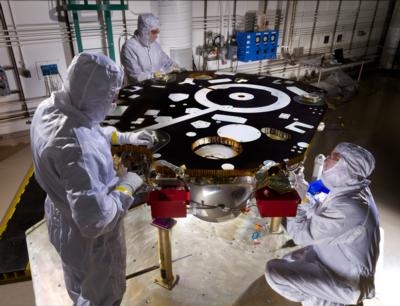'InSight' On Track For March, 2016 Launch
NASA's InSight mission has begun the assembly, test and launch operations (ATLO) phase of its development, on track for a March 2016 launch to Mars.

The lander, its aeroshell and cruise stage are being assembled by Lockheed Martin Space Systems, Denver.
"Reaching this stage that we call ATLO is a critical milestone," said InSight Project Manager Tom Hoffman at NASA's Jet Propulsion Laboratory, Pasadena, California. "This is a very satisfying point of the mission as we transition from many teams working on their individual elements to integrating these elements into a functioning system. The subsystems are coming from all over the globe, and the ATLO team works to integrate them into the flight vehicle. We will then move rapidly to rigorous testing when the spacecraft has been assembled, and then to the launch preparations."
Over the next six months, technicians at Lockheed Martin will add subsystems such as avionics, power, telecomm, mechanisms, thermal systems and navigation systems onto the spacecraft. The propulsion system was installed earlier this year on the lander's main structure.
"The InSight mission is a mix of tried-and-true and new-and-exciting. The spacecraft has a lot of heritage from Phoenix and even back to the Viking landers, but the science has never been done before at Mars," said Stu Spath, InSight program manager at Lockheed Martin Space Systems. "Physically, InSight looks a lot like the Phoenix lander we built, but most of the electronic components are similar to what is currently flying on the MAVEN spacecraft."
InSight stands for "Interior Exploration using Seismic Investigations, Geodesy and Heat Transport," and it is more than a Mars mission. This NASA Discovery-class mission is a terrestrial planet explorer that will address one of the most fundamental issues of planetary and solar system science: understanding the processes that shaped the rocky planets of the inner solar system (including Earth) more than four billion years ago.
To investigate the planet's interior, the stationary lander will carry a robotic arm that will deploy surface and burrowing instruments contributed by France and Germany. The national space agencies of France and Germany -- Centre National d'Etudes Spatiales (CNES) and Deutsches Zentrum für Luft- und Raumfahrt (DLR), respectively -- are partnering with NASA by providing InSight's two main science instruments.
The Seismic Experiment for Interior Structure (SEIS) will be built by CNES in partnership with DLR and the space agencies of Switzerland and the United Kingdom. It will measure waves of ground motion carried through the interior of the planet, from "marsquakes" and meteor impacts. The Heat Flow and Physical Properties Package, from DLR, will measure heat coming toward the surface from the planet's interior.
Guided by images of the surroundings taken by the lander, InSight's robotic arm will place the seismometer on the surface and then place a protective covering over it to minimize effects of wind and temperature on the sensitive instrument. The arm will also put the heat-flow probe in position to hammer itself into the ground to a depth of 3 to 5 yards, or meters.
Another experiment will use the radio link between InSight and NASA's Deep Space Network antennas on Earth to measure precisely a wobble in Mars' rotation that could reveal whether the planet has a molten or solid core. Wind and temperature sensors from Spain's Centro de Astrobiologia and a pressure sensor will monitor weather at the landing site, and a magnetometer will measure magnetic disturbances caused by the Martian ionosphere.
(Image provided by Lockheed Martin. Technicians in a Lockheed Martin clean room near Denver prepare NASA's InSight Mars lander for propulsion proof and leak testing on Oct. 31, 2014. Following the test, the lander was moved to another clean room for start of the mission's assembly, test and launch operations (ATLO) phase)
 ANN's Daily Aero-Linx (04.13.24)
ANN's Daily Aero-Linx (04.13.24) ANN's Daily Aero-Term (04.13.24): Beyond Visual Line Of Sight (BVLOS)
ANN's Daily Aero-Term (04.13.24): Beyond Visual Line Of Sight (BVLOS) Airborne 04.09.24: SnF24!, Piper-DeltaHawk!, Fisher Update, Junkers
Airborne 04.09.24: SnF24!, Piper-DeltaHawk!, Fisher Update, Junkers Aero-News: Quote of the Day (04.14.24)
Aero-News: Quote of the Day (04.14.24) ANN's Daily Aero-Term (04.14.24): Maximum Authorized Altitude
ANN's Daily Aero-Term (04.14.24): Maximum Authorized Altitude



